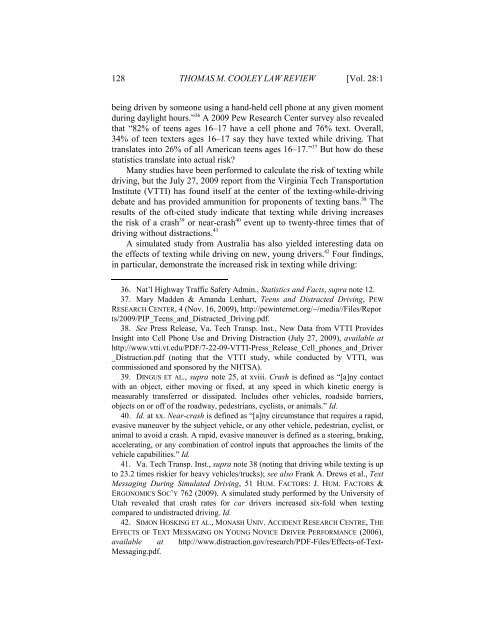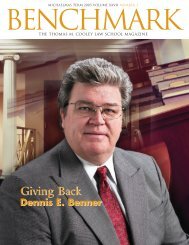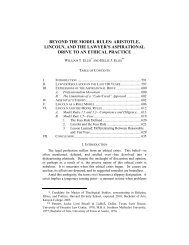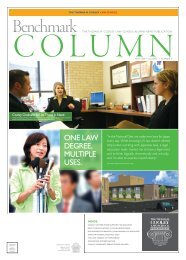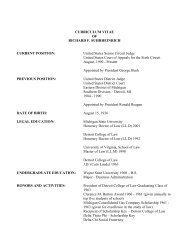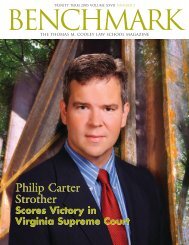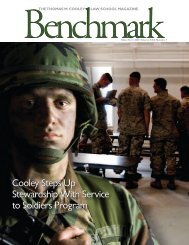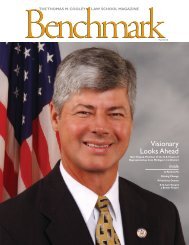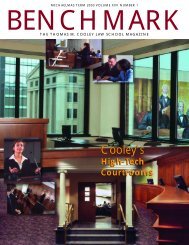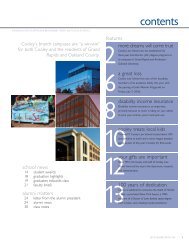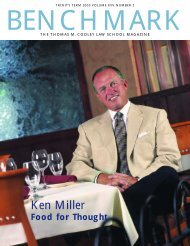Michigan's Texting Ban: One Step Forward, Too Many Steps Back
Michigan's Texting Ban: One Step Forward, Too Many Steps Back
Michigan's Texting Ban: One Step Forward, Too Many Steps Back
- No tags were found...
You also want an ePaper? Increase the reach of your titles
YUMPU automatically turns print PDFs into web optimized ePapers that Google loves.
128 THOMAS M. COOLEY LAW REVIEW [Vol. 28:1being driven by someone using a hand-held cell phone at any given momentduring daylight hours.” 36 A 2009 Pew Research Center survey also revealedthat “82% of teens ages 16–17 have a cell phone and 76% text. Overall,34% of teen texters ages 16–17 say they have texted while driving. Thattranslates into 26% of all American teens ages 16–17.” 37 But how do thesestatistics translate into actual risk?<strong>Many</strong> studies have been performed to calculate the risk of texting whiledriving, but the July 27, 2009 report from the Virginia Tech TransportationInstitute (VTTI) has found itself at the center of the texting-while-drivingdebate and has provided ammunition for proponents of texting bans. 38 Theresults of the oft-cited study indicate that texting while driving increasesthe risk of a crash 39 or near-crash 40 event up to twenty-three times that ofdriving without distractions. 41A simulated study from Australia has also yielded interesting data onthe effects of texting while driving on new, young drivers. 42 Four findings,in particular, demonstrate the increased risk in texting while driving:36. Nat’l Highway Traffic Safety Admin., Statistics and Facts, supra note 12.37. Mary Madden & Amanda Lenhart, Teens and Distracted Driving, PEWRESEARCH CENTER, 4 (Nov. 16, 2009), http://pewinternet.org/~/media//Files/Reports/2009/PIP_Teens_and_Distracted_Driving.pdf.38. See Press Release, Va. Tech Transp. Inst., New Data from VTTI ProvidesInsight into Cell Phone Use and Driving Distraction (July 27, 2009), available athttp://www.vtti.vt.edu/PDF/7-22-09-VTTI-Press_Release_Cell_phones_and_Driver_Distraction.pdf (noting that the VTTI study, while conducted by VTTI, wascommissioned and sponsored by the NHTSA).39. DINGUS ET AL., supra note 25, at xviii. Crash is defined as “[a]ny contactwith an object, either moving or fixed, at any speed in which kinetic energy ismeasurably transferred or dissipated. Includes other vehicles, roadside barriers,objects on or off of the roadway, pedestrians, cyclists, or animals.” Id.40. Id. at xx. Near-crash is defined as “[a]ny circumstance that requires a rapid,evasive maneuver by the subject vehicle, or any other vehicle, pedestrian, cyclist, oranimal to avoid a crash. A rapid, evasive maneuver is defined as a steering, braking,accelerating, or any combination of control inputs that approaches the limits of thevehicle capabilities.” Id.41. Va. Tech Transp. Inst., supra note 38 (noting that driving while texting is upto 23.2 times riskier for heavy vehicles/trucks); see also Frank A. Drews et al., TextMessaging During Simulated Driving, 51 HUM. FACTORS: J. HUM. FACTORS &ERGONOMICS SOC’Y 762 (2009). A simulated study performed by the University ofUtah revealed that crash rates for car drivers increased six-fold when textingcompared to undistracted driving. Id.42. SIMON HOSKING ET AL., MONASH UNIV. ACCIDENT RESEARCH CENTRE, THEEFFECTS OF TEXT MESSAGING ON YOUNG NOVICE DRIVER PERFORMANCE (2006),available at http://www.distraction.gov/research/PDF-Files/Effects-of-Text-Messaging.pdf.


